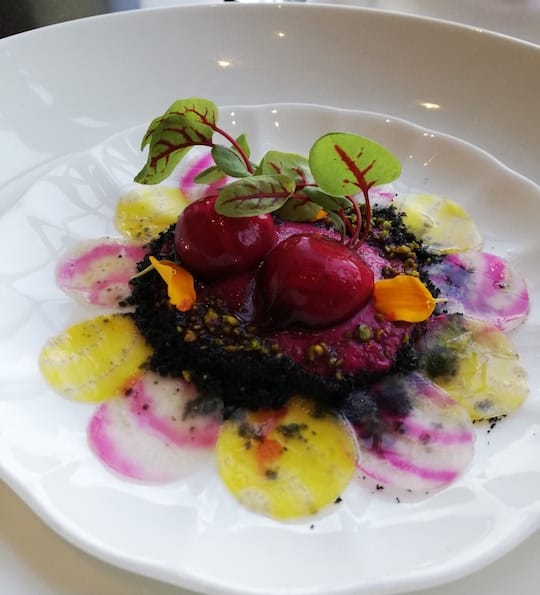However, Ukrainian chef Iurii Kovryzhenko is working hard to alter the cuisine’s stodgy image. Kovryzhenko, who is a well-known food ambassador in Ukraine, has worked in the dining scene for more than two decades.
“There have been new waves in French, Nordic and Spanish cuisine, but in Ukraine, people have been eating very much the same type of food that they grew up with," he says. "Culinary schools in Ukraine are mostly old-school, so we must give young chefs an interesting future to look forward to.”
“I use flowers in my dishes as if they are regular ingredients, instead of just garnishes,” he says. “Designing a dish with flowers is like painting—you can experiment and play around with colors and flavors.”
We catch up with Kovryzhenko to find out how he is transforming Ukrainian dishes with a floral finish.

What are some of your favorite modern Ukrainian dishes?
Boiled beetroot is classically served with bryndza (a salted sheep milk’s cheese from the Carpathian mountains in Ukraine), honey and horseradish. I have re-imagined this dish as a “beetroot” that is stuffed with mozzarella cheese. The exterior is made with dark pink beetroot juice jelly, which sits on a bed of horseradish puree that injects spiciness into the dish.
For chicken liver pâté, I have added black truffles, which are grown in Vinnytsia in west-central Ukraine—given the recent surge in increase in using homegrown ingredients. Ukrainians typically have warm pâté but I like to serve it chilled, which gives it a smooth and buttery texture.
How are you modernizing Ukrainian cuisine?
My aim is to stay true to the essence of regional Ukrainian cooking in my dishes, but their appearance can be entirely different, which adds an element of surprise. Many classic dishes are not meant to create an impression in restaurants, so it is time to shake things up. Take our classic borscht: I have made a deconstructed version of the soup that comprises beetroot jelly, puree, flowers and greens.
That said, I still work with elements of Ukrainian cuisine, such as root vegetables and dairy products like sour cream, which is a big part of our culinary culture. Ukrainian dishes do not have intense flavors as seasonings mainly revolve around coriander seeds, black pepper, horseradish, thyme and mustard.
RELATED: 5 Ukrainian Ingredients to Stock Up On

Where do you go to seek inspiration for your cuisine?
It is through traveling that I look out for new inspirations and expose myself to new flavor combinations and ingredients. In Singapore, I have broadened my food horizons by dining at MICHELIN-starred restaurants such as Odette and JAAN By Kirk Westaway. Recently, I was so intrigued by laksa that I brought backpacks of the spice paste and coconut milk to Ukraine to make sauces to accompany meat and potato dishes.
How did your interest in cooking start?
I took a long route to get into the kitchen. I started out as sculptor and even had a brief stint in international relations. While my grandmother and mother are great cooks, my interest to pursue a culinary career only began when I was around 29 years old.
Then I was in university and worked part-time in a restaurant for my allowance. I started out as service staff, but I found my calling in the kitchen. I fell in love with cooking as it was a chance to showcase my artistic skills, through plating and working with the colors of ingredients.

Share with us more about your interest in fleur cuisine.
Flowers are more than mere garnishes on the plate as there is so much to explore about their flavors and textures. Flowers are actually very versatile in dishes. Marigolds have a tinge of spiciness, which can be easily incorporated into meat-based main courses, while violets inject a tender texture and perfume dishes, especially desserts, well. I usually use nasturtium
in appetizers and salads.















